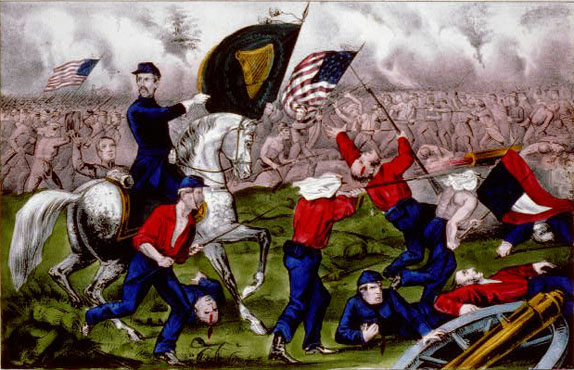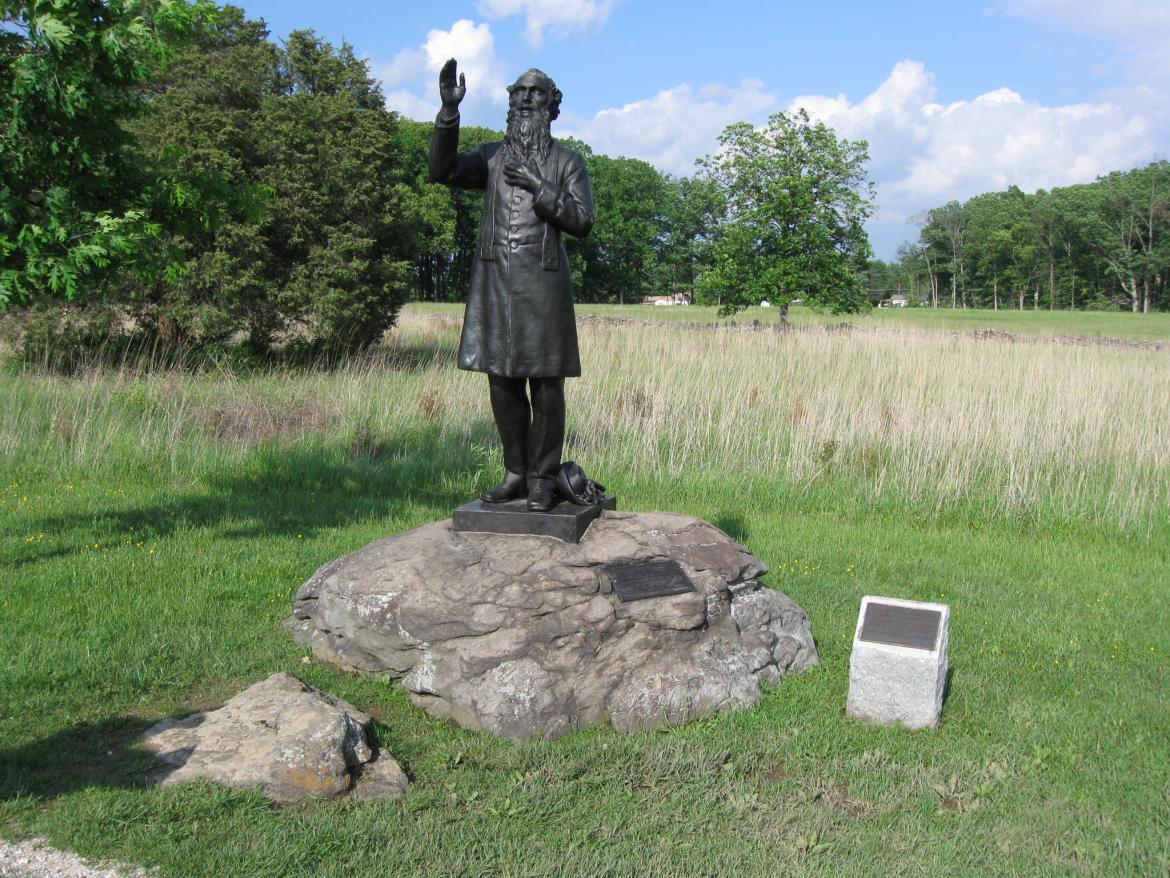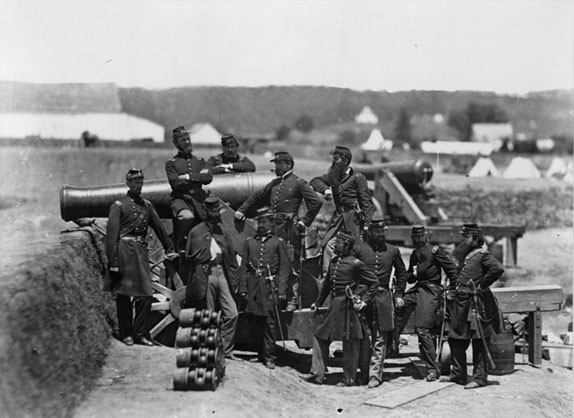Irish Brigade at Gettysburg Part 2: Licensed Battlefield Guide John Fitzpatrick
On April 15, 1861, shortly after Fort Sumter in Charleston, SC surrendered to the Confederates whose bombardment of that US Fort was the first shot of the American Civil War, President Lincoln called for 75,000 volunteers to defend the Capitol. The second regiment to march from New York City in response to that call was the 69th New York State Militia commanded by Colonel Michael Corcoran, born in County Sligo, Ireland in 1827. He is standing on the left, his left hand on the left wheel of the siege gun carriage. He, the officers and men of the regiment built and manned Fort Corcoran in the Spring of 1861 near the Capitol. The only Officer on the far side of the gun, leaning on the tube and looking directly into the camera is Captain-Acting Major, Thomas Francis Meagher born in Waterford, Ireland. [Photo courtesy of Library of Congress]
Gettysburg Licensed Battlefield Guide John J. Fitzpatrick, Jr., Esq. is host for a series on the Irish Brigade at Gettysburg. John’s interest in Gettysburg began in centennial year of 1963 when he arranged a trip to the Battlefield for the Villanova University Student History Club. That sparked a continuing interest in the American Civil War. Throughout his travels in the Service, work and some vacations he has been to Civil War sites coast to coast from Fort Point under the Golden Gate Bridge, San Francisco, California to the home, church and College of Joshua Lawrence Chamberlain in Brunswick, Maine. He is now entering upon his eighth year of Guiding at Gettysburg.
His professional career began in 1966 as a United States Marine Corps Officer, Tank Platoon Commander then Pilot. He served a combat tour of duty in Vietnam completing 140 missions in the A6 Intruder for which he was awarded 9 Air Medals and Vietnam Service Awards. Captain Fitzpatrick was Honorably Discharged from Active Duty in 1971 whereupon he entered law school. Upon graduation in 1974 he began a 32 year career as Corporate Counsel for Gulf Oil and Chevron Corporation retiring in 2006. He is a Member in good standing before the highest Courts in Pennsylvania, the District of Columbia and California.
Contemporaneously with his first legal job, he transferred to the Pennsylvania Air National Guard and later the U.S. Air Force Reserve. He served as an Active Reservist Pilot/Forward Air Controller/Squadron and Group Training Officer at the Willow Grove NAS, PA from 1974-1984. He was transferred to HQ USAF at the Pentagon in Legislative Liaison from 1985-1993 and finally as a JAG Officer reporting to the USAF TJAG and General Counsel from 1993-1997 based on his civilian expertise to assist the Air Force with its new Arbitration and Mediation Programs. Colonel Fitzpatrick received 3 Meritorious Service Medals, the Air Force Commendation Medal and other Awards before transferring to the Retired Reserve in 1997. He now divides his time amongst Guiding at Gettysburg, certain volunteer Veterans’ activities and serving as an Arbitrator in commercial, construction and securities cases.
John Fitzpatrick writes; “I appreciate the earlier related postings of my fellow Guides Rich Bellamy [Colonel Cross in the Wheatfield], the Editor of this Gettysburg Daily, Bobby Housch specifically for his postings of November 8 and 15, 2010 of the Weikert Lane [one of the most likely Avenues of Approach used by the Irish Brigade when it deployed to the Wheatfield in the late afternoon of July 2, 1863] and Dr. Rich Goedkoop’s posting of President Kennedy’s 1963 visit to Gettysburg. I also want to thank Licensed Battlefield Guides Rich Kohr for his posting on the Gettysburg Electric Railway and Ralph Siegel for sharing his expertise on the artillery fight at the Peach Orchard."
“I also appreciate permission to use:
• New York’s Bravest, Painting by Don Troiani, www.historicalimagebank.com;
• Remember Ireland and Fontenoy, Painting by Rick Reeves, permission from Rick Reeves, rickreevesstudio.com;
• Pride of Erin, Painting by Dale Gallon, permission from Ms. Anne Gallon of Gallon Historical Art, Gettysburg, PA, www.Gallon.com;
• The Prince of Wales Flag courtesy of Erik Chipchase at mercenarygraphics.com."
To contact John, please click here to reveal his email address.
In our first Irish Brigade post, Gettysburg Licensed Battlefield Guide John Fitzpatrick introduced us to the series on the Irish Brigade and brings the Irish to the battlefield at Gettysburg.
In today's Irish Brigade post, Gettysburg Licensed Battlefield Guide John Fitzpatrick shows their position in the Order of Battle of the Federal Army of the Potomac, and in John's words, "their unique heritage of defiance to overweening, arbitrary authority and a profound spiritual and ecumenical moment prior to their deployment into the battle at the Wheatfield and Stony Hill on July 2, 1863."

This map shows the location of the Irish Brigade videos. Video #1-#3 were taken along Cemetery Ridge south of the Pennsylvania State Memorial. Video #4 was taken by the marker to Caldwell's Division. Videos #5 and #6 were taken by the Father Corby statue. This map was created facing north at approximately 7:00 AM on Sunday, May 29, 2011.

Gettysburg Licensed Battlefield Guide John Fitzpatrick is the host for our series on the Irish Brigade. He is standing on Cemetery Ridge by the marker to Caldwell's Division. This view was taken facing east at approximately 5:15 PM on Friday, May 20, 2011.
Fitzpatrick 052011 004 In Video #4 Gettysburg Licensed Battlefield Guide John Fitzpatrick is standing on Cemetery Ridge near the marker for Caldwell's Division. He shows the numerical designation of the Irish Brigade in Caldwell's Division and some background on the Irish Brigade. This view was taken facing east at approximately 5:15 PM on Friday, May 20, 2011.

A view of the text on the marker for Caldwell's Division. This view was taken facing east at approximately 5:15 PM on Friday, May 20, 2011.

A closer view of the order of battle of Caldwell's Division. This view was taken facing east at approximately 5:15 PM on Friday, May 20, 2011.

The 69th New York State Militia is depicted in action at the first Battle of Bull Run, July 21, 1861. They were part of Sherman’s Brigade which was fed into the fight piecemeal. Depicted is their afternoon fight on the plateau of Henry House Hill with the remnants of the 11th New York Fire Zouaves [who had previously attacked] against the Confederates’ remnants of Bee, Bartow and Evan’s Brigades and Jackson’s newly arrived Brigade and artillery. After several attacks and counter attacks, the 69th NYSM will try to fight as a rear guard, but they will join the retreat. Colonel Corcoran will be captured. Colonel Corcoran will be offered parole in exchange for refusing to take up arms against the Confederacy. He refuses and will not be exchanged until 13 months later. He is appointed Brigadier General of Volunteers, recruits Corcoran’s “Irish Legion” and while commanding a Division of the XXII Corps in defense of Washington City his horse fell on him while he was riding alone, fracturing his skull and killing him on December 22, 1863. This painting by Don Troiani is titled New York’s Bravest. It is courtesy of www.historicalimagebank.com.

This image is titled "Colonel Michael Corcoran at the Battle of Bull Run, July 21, 1861." The flag with the harp in this image by Courier and Ives is not accurate. This Courier and Ives print is courtesy of the Library of Congress.

At the Battle of First Manassas on July 21st, 1861, Captain Thomas Francis Meagher of the 69th New York State Militia had his horse shot from under him by an artilery projectile. Meagher, that day acting as major for the regiment, sprang to his feet and shouted, "Boys! look at that flag--remember Ireland and Fontenoy." This painting by Rick Reeves is titled "Remember Ireland and Fontenoy" and is courtesy of rickreevesstudio.com.

Brigadier General Thomas Francis Meagher “Of the Sword” was born in 1823 in Waterford, Ireland into a family with a successful shipping business. An educated, independent thinking, passionate orator and firm admirer of the American and French Revolutions, he had hoped to bridge the “Catholic” vs. “Protestant” divide in a common goal of uniting all Ireland as citizens and free men with their own indigenous non-denominational Parliament. He earned his sobriquet in 1846 when he argued that at some point only armed revolt might achieve political change. He firmly declared to the crowd; “Abhor the sword? Stigmatize the sword? No, my lord…” three times including passionate references to the American Revolution and the Battle of Fontenoy in the War of Austrian Succession in 1745. He joined the “Young Ireland” movement and participated in the failed revolt of 1848. He was tried, convicted and sentenced to execution but the public outcry lead to a sentence of life imprisonment on Van Diemen’s island near the southeastern coast of Australia. He escaped, made his way to New York, became a lawyer, orator and joined the 69th NYSM. He participated in the Battle of Bull Run [he is the Officer in the center, sword arm outstretched, in each of the latter two paintings above] and personally recruited the 69th, 88th and 63rd NY Volunteer Infantry Regiments. On February 5, 1862 he was appointed Brigadier General. Immediately prior to the Battle of Fredericksburg in December 1862, the 28th Massachusetts and 116th Pennsylvania Regiments were added to the “Irish Brigade” in the Army of the Potomac. Meagher commanded the Brigade through the Peninsula, the Seven Days, Antietam, Fredericksburg and Chancellorsville. When his requests for leave and the opportunity to recruit replacements for the depleted Brigade were denied, he resigned on May 8, 1862. He is the reason that the Irish Brigade was armed with the Springfield, Model 1842, smooth bore, .69 calibre “buck and ball” musket at the Battle of Gettysburg. This image is reproduced courtesy of The Huntington Library, San Marino, California.

Father William Corby, CSC is seated on the right of this image taken at Harrison’s Landing during the 1862 Peninsula Campaign. The man to his right and the man standing on the right are also priest-chaplains from the University of Notre Dame. Father Corby, technically the Chaplain of the 88th New York, was the actual Chaplain for the entire Irish Brigade at Gettysburg in that one chaplain was sick and the other serving at a military hospital in Washington, D.C. This image is courtesy of the Library of Congress.

Licensed Battlefield Guide John Fitzpatrick is standing on Cemetery Ridge, next to Father William Corby’s statue on Hancock Avenue. This location is approximately 500 yards south of the Pennsylvania Memorial near where the actual event took place. The Brigade would not have broken ranks from its Division. Rocks were cleared in 1910 to make way for the Pennsylvania Memorial so it is quite possible that the Gettysburg statue, dedicated also in 1910, is on the same rock on which he stood in 1863. At the time, however, the rock was located in the area of the Pennsylvania State Monument. This view was taken facing northeast at approximately 5:15 PM on Friday, May 20, 2011.
Fitzpatrick 052011 005 In Video #5 Licensed Battlefield Guide John Fitzpatrick is standing on Cemetery Ridge near the statue of Father William Corby. He explains where Corby performed the general absolution on July 2, 1863. This video was taken facing northeast to north at approximately 5:15 PM on Friday, May 20, 2011.

Far be it from us to say, but the fact that the tourist-driven Gettysburg Electric Trolley (1893-1916) ran right past the statue might have had something to do with its placement. This view was taken facing northeast at approximately 5:15 PM on Friday, May 20, 2011.

This photograph is of a duplicate statue on the campus of the University of Notre Dame. Father Corby served two terms as President of the University of Notre Dame. Given the American sense of humor and Notre Dame’s reputation as a highly competitive, renowned and storied college football team, it is reported that the statue on campus is affectionately known as “Fair Catch Corby”. This image is courtesy of the University of Notre Dame Archives.

At some point in time, most likely mid-morning, after the Irish Brigade’s arrival on the field at approximately 7:00 AM, July 2, 1863, and prior to their first movement to the fight south from that position at approximately 4:00 PM, Father Corby requested and received permission from the Brigade Commander, Colonel Patrick Kelly, to address the men. He put on his purple stole around his neck, climbed a rock, explained general absolution, urged the men to silently confess their sins, do their duty and to remember the seriousness of the trust placed in them as soldiers. He then said the Latin words of absolution as he blessed them with the Sign of the Cross. In his memoirs he later wrote; “…the general absolution was meant for all…not only for our brigade, but for all, North or South who were susceptible of it and all who were about to appear before their Judge.” The group of officers watching on horseback includes their Second Corps Commander, Major General Winfield Scott Hancock. This painting by Paul Wood (1871-1892) is courtesy of the University of Notre Dame Archives.

John Fitzpatrick is standing on Cemetery Ridge's Hancock Avenue. The Father William Corby statue is in the right background. The Pennsylvania State Monument is visible at the "end" of Hancock Avenue. Acutally of course, Hancock Avenue goes to the left or west of the Pennsylvania Monument. This view was taken facing north at approximately 5:15 PM on Friday, May 20, 2011.
Fitzpatrick 052011 006 In Video #6 Licensed Battlefield Guide John Fitzpatrick is standing on Cemetery Ridge. He explains the story behind the "Prince of Wales Flag." This video was taken facing north at approximately 5:15 PM on Friday, May 20, 2011.

This is the “Prince of Wales” flag which clearly and unambiguously refers to October 11, 1860 which is the date when the 18 year old Prince of Wales, son of Queen Victoria, later King Edward VII, visited New York City. The upper red riband on that flag reads, “PRESENTED TO THE 69TH REGIMENT." The lower red riband reads, IN COMMEMORATION OF THE 11TH OCT. 1860." The 69th New York State Militia was ordered to march in a parade in his honor. Colonel Corcoran refused. He was protesting the inadequate and ineffective response of the British government to the potato famine in Ireland [1845-1850] where approximately one million Irish-British subjects starved to death and approximately another two million emigrated in coffin ships to Australia, Canada and the United States. Corcoran was relieved of command and court-martial proceedings were instituted. The charges were dropped when the 69th New York State Militia responded to President Lincoln’s call to defend Washington City. The painting of the Prince of Wales Flag is courtesy of artist Erik Chipchase at echipchase@mercenarygraphics.com.

This is the second "Green Flag" of the 63rd New York Infantry Regiment. The “First” Green Flags of the 69th, 88th and 63rd New York Volunteer Infantry, the core Regiments of the Irish Brigade. They were so badly damaged, particularly during the fight in front of the sunken “Bloody Lane” at the Battle of Antietam, September 17, 1862, that replacement flags were ordered. Please note the date of November 1862 in the lower left of “BRISTOE STATION”. The flags did not arrive in time to be officially adopted prior to the Battle of Fredericksburg, December 13, 1862, but they were issued to each regiment well before the battle of Gettysburg. Father Corby returned to Notre Dame and served two terms as President of the University. He specifically requested that, upon his death, he would be buried with a military funeral. It was granted and many Irish Brigade veterans and their families participated. This restored Second Green Flag of the 63rd New York Volunteer Infantry was donated to the University by those Veterans in his honor and memory. This image is courtesy of the University of Notre Dame Archives.
To see other posts by Gettysburg Licensed Battlefield Guides, click here.
















